Artists reveal their secrets for smart editing and smooth studio visits
Not too long ago, I paid a call on an artist who shall remain nameless, whose studio was such a shambles I was itching to get out of there within ten minutes. It seemed there were works from every period of his 30-year career—prints and paintings and drawings—pinned to every available surface, in no particular order. Even a guided tour of the premises did little to allay the confusion, and I left with the impression that if this guy ever had to move out he’d probably have a nervous breakdown.
Which led to the question: How do you edit down your works prior to a visit from a writer, a dealer, or a curator? Whom do you trust to help you weed out the good from the bad from the meh?
I reached out to about 15 artists to get their responses, and heard from ten. The question devolved naturally into tips for setting up for a studio visit, so I include those as well, believing that you can never have too much advice when it comes to presenting your work in the best possible way.
Mary Zeran: Since wall space is at a premium in my studio, I tend to show four to six current completed pieces. If the visitor is interested in seeing the chronology, I have a portfolio that they can flip through. I also have albums devoted to different series on my iPad.
Editing out the good from the bad, and the so-so work can be tough. I think I have a pretty good feel for what works and what doesn’t, but it’s the so-so pieces that are difficult. Since I work from home, I don’t get a lot of critiques, though I have a few people whose opinion I trust. I have a monthly lunch date with the director of a local museum. We tend to look at my iPad portfolio and discuss what works and why. I really trust his judgment because he’s watched my work evolve for the last eight years, and he has an experienced eye. I also rely on the staff at my local gallery for input.
In general, I’m extremely selective about whose opinion I listen to, and I’m careful about those I invite to my studio. People can make comments that sting. That doesn’t mean they aren’t constructive; it can just take a long time to see their point of view. Even though it’s been years since I was in art school, I can still remember the critiques. There was always someone who offered criticism that had no relevance to what you were doing, or the one who wanted to make you cry. Now that I’m in control of my work environment, I stay away from those people. Especially the ones that make me cry.
Donald Martiny: I curate my work for studio visits by cleaning and organizing my space, thinking of my presentation as a narrative story. I have found it effective to place sketches, studies, and maquettes in plain view and lead the visitor from those to the finished works, so that the developmental process is clearly evident.
It’s important for the visitor to be comfortable, but not too comfortable, so I offer something simple to drink like water or tea, and some almonds or blueberries. If the visit goes long and leads to a serious, extended conversation, I am always prepared to offer more interesting food and drink.
As for editing my work. I almost never collaborate or discuss what I’m going to show, as I have a good handle on what I want the visit to achieve. When I do discuss my choices, it is with my wife, Celia Johnson, who is a painter with an amazing eye, and who always tells me the hard truth.
Celia Johnson: I have a very small studio in my house, and so there is a built-in need for organizational efficiency and focus to maximize the limited space. For me, clutter is an attention killer, and I don’t intentionally leave a lot of process materials about (I also like visitors to wonder a bit how I do what I do).
I will very carefully prepare and select only targeted work for the curator or gallerist. The take-away should be my strongest work.
Additionally, I set up my laptop, opened to my website. It is here that I may point to past series and collections to broaden the overview of my development, if that seems relevant or important to the context of the visit. Only then will I entertain bringing out an older work if it is specifically requested and available in my inventory.
I have a very trusted studio mate who tells me how it is. The only person I trust is my husband, Don Martiny.
Beverly Rippel: I started a studio practice nearly 40 years ago and have developed several bodies of work. I have a large studio in an old boot factory by the Stoughton, MA, train station, where I work and store paintings and supplies. When I have hosted studio visits there, they have been for curators looking for a particular series. I clean up, take everything off the walls, and mount a cohesive, easy-to -view show of just the work they are interested in. I have on reserve pertinent publications and works on paper, journals, and post-it notes that helped to create the work I am presenting.
I don’t have a “go-to” person that I ask to edit. I have showed and continue to show in galleries and museums, but at the moment I don’t have gallery representation. Over the years I have come to respect a few writers, editors, and museum directors: the late Carl Belz, director emeritus at the Rose Art Museum; Brian Goslow, managing editor of Artscope Magazine, Malcolm Rogers, former director at Boston’s Museum of Fine Arts; and Sebastian Smee, the Pulitzer Prize-winning critic from the Boston Globe.
I also have had a Boston Arts District studio in the South End for seven years. I work there as well, but I present it like a well-installed gallery space for “First Friday” open-studio events, and on Sundays and by appointment. Here I have the wonderful opportunity to talk with dealers, visitors, art students, curators, writers, and so on, and share with them the connections between bodies of work on the wall. I like to listen to their interpretations first before I reveal my personal intentions. That is absolutely the best!
Teresa Stanley: I spend hours in deep conversation with my work and because of this familiarity I can see my paintings even among the chaos that accompanies a working studio. However, I can’t expect that a stranger coming to my studio to be able to see the work as I do. Presentation is important and that entails editing the work down to my very best and not showing everything, cleaning up and perhaps freshly painting a studio wall. Sometimes I think it’s useful to have out a few things that inspire me—sketches, notes, pictures, books, objects. These can help clue the visitor into your working process and intentions.
As for choosing what work to show or not, I rely heavily on my husband, Jack Bentley, who is also an artist and a curator. I trust that he understands what I’m doing, and he is not afraid to give me his honest opinion. Other than Jack, I have a couple of artist friends I can rely on. It is important to have someone around who can be frank with you and not just be a cheerleader.
It’s often difficult to be objective about your own work. I’ve heard other artists say that the work that they initially feel most insecure about turns out to be their best. For that reason, I’ve found the iPhone to be a useful studio tool. Somehow taking pictures and looking at them on your phone helps you to create the necessary distance between yourself and the work. It’s like a magic mirror that reveals the truth that is otherwise not apparent to the naked eye.
Lee Hill: With a modest budget, I developed a 400-square-foot space in my garage, solely dedicated to painting. I designed a central working wall that is about nine by nine feet, figuring I wouldn’t be painting anything larger than eight feet in any direction. This wall is easily re-paintable and doubles as an exhibit wall during studio visits. I also made sure to provide lots of light and as much vertical storage space as possible for paintings. Since the space is small and has multiple overlapping functions, I keep it meticulously clean and organized so that I’m always ready to show work at a moment’s notice.
As for whom I trust to edit good from bad—many times it’s just me. Since I’ve been painting so long and have made it a point to see lots of work, analyzing what’s successful and what’s not, I believe it’s part of my responsibility as an artist to develop a sensibility for editing and curating. I also try to know my audience. But if I’m in doubt, I turn to my 16-year-old daughter, Sydney. She’s the one who has been at my side in the studio all these years, intimately watching me develop, and she’s not inhibited about her opinions. She’s also great in gallery situations and picks up a lot of intel that I couldn’t possibly get on my own. My 17-year-old son, Ryan, on the other hand, is interested in the process side of my work and often makes great suggestions for patterns, colors, titles and approaches to hanging.
Karen Schifano: As far as editing goes, I basically trust my own instincts, although sometimes I have asked my spouse about particular works. I also asked an artist friend about the wisdom of showing new work first, and earlier work later, and keeping more work available in stacks just in case—and she agreed. There are several walls in my studio where I can display work, and so I set things up in groups on each wall. I usually hang paintings for viewing a day or two in advance, taking care not to put up too much all at once. Also, I try and make sure there’s plenty of wall space around each painting, rather than having a set-up that feels visually confusing. I keep my studio pretty clean, set out some food and seltzer or tea, and also prepare a small selection of catalogs as well as a copy of my short-version résumé and business card for visitors to take away.
Helen Harrison: My gallery is a studio/gallery, meaning it’s where my work is done. Over the years, I’ve found that I tend to listen to those I respect more during the creation of a piece than I do with the outcome because I am the ultimate judge of that. I think it’s only natural that artists “like” certain works more than others, but after 32 years as a gallery owner, my ultimate gut check is how it displays itself in the gallery or where it is to be installed.
Always the artist and, at other times, a curator and dealer, I try to put my best foot forward for myself and the artists I am representing. Lighting and presentation are incredibly important. I am extremely selective and let each piece breathe. I disapprove of a cluttered gallery, and I do my best to keep the studio organized. Because I’ve been a working artist for some 40 years, many of my pieces are no longer available. To give a curator, writer, or dealer a greater appreciation of my past, chronologically and categorically, I rely on my iPad to display this visual archive.
Christopher Benson: I’m very conscious of the person who’s coming to see the work and what it is they’re tuned into. Having behind me a 40-year career in which I’ve tackled a variety of subjects, I would load the dice toward the area of interest that person has. And that’s the same way I feel about showing work to galleries. You get to know who the dealers are. You look very carefully at their roster of artists; you get to know them better before you spring your own work on them. I think that’s something that 90 percent of artists don’t understand. We all want attention and want people to love us and love what we do, and yet we forget there’s someone on the other end of the transaction.
Karen Snouffer: At times, I invite an academic colleague, Craig Hill, to help edit my work before a studio visit. I trust him to see things objectively, because he is in tune with current artists and exceptionally well versed in technique. Also, the artist-collector Francie Bishop Good sees my work online, and I fully trust her reactions because of her impressively trained eye.
I work hard to prepare my studio before a visit. I want my work, which is grounded in visual and physical movement, to convey an immediate, energizing, large-scale impact; then a visitor can discover groupings arranged logically within the space. My smaller-scale installation- and performance-based works are in delineated areas of my studio, so when Karin Bravin of BravinLee Programs visited, she was able to give me creative suggestions on framing/hanging and balancing these three fields of my practice.
My studio spaces are orderly but to make my processes evident, I leave out materials at work stations. I do not put out everything, just the strongest from the last year or two; then I arrange groupings in corners or drawers that I can access easily if a gallerist asks questions that lead to showing her more work.
Ann Landi
Top: Karen Snouffer’s studio in Gambier, OH
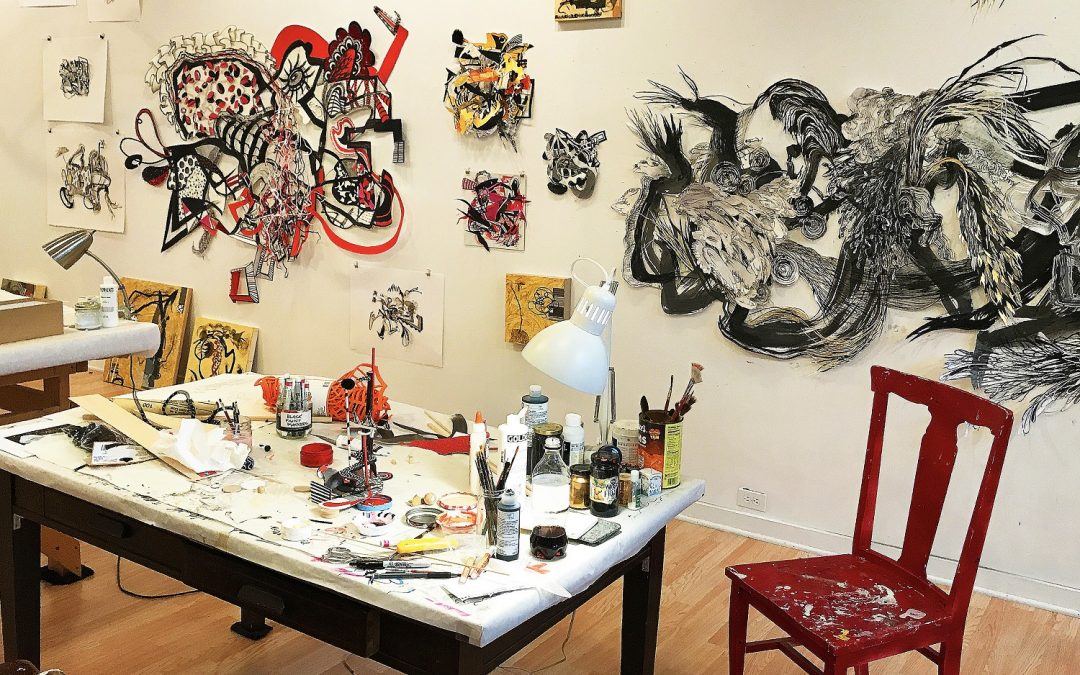
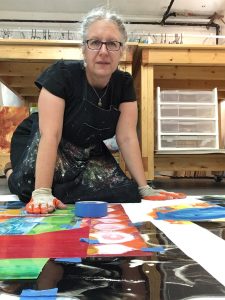
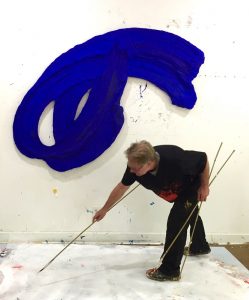
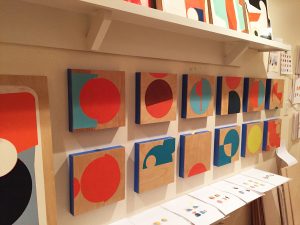
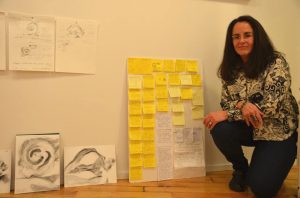
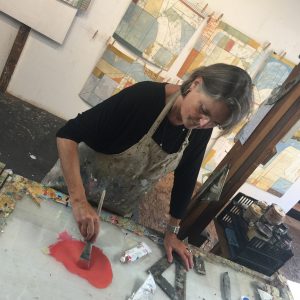
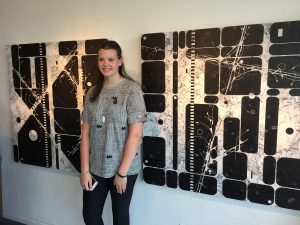
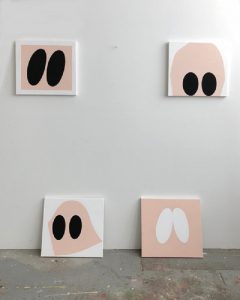
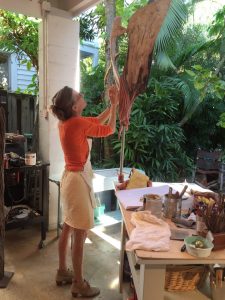
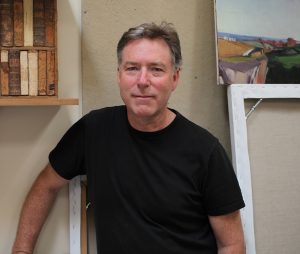
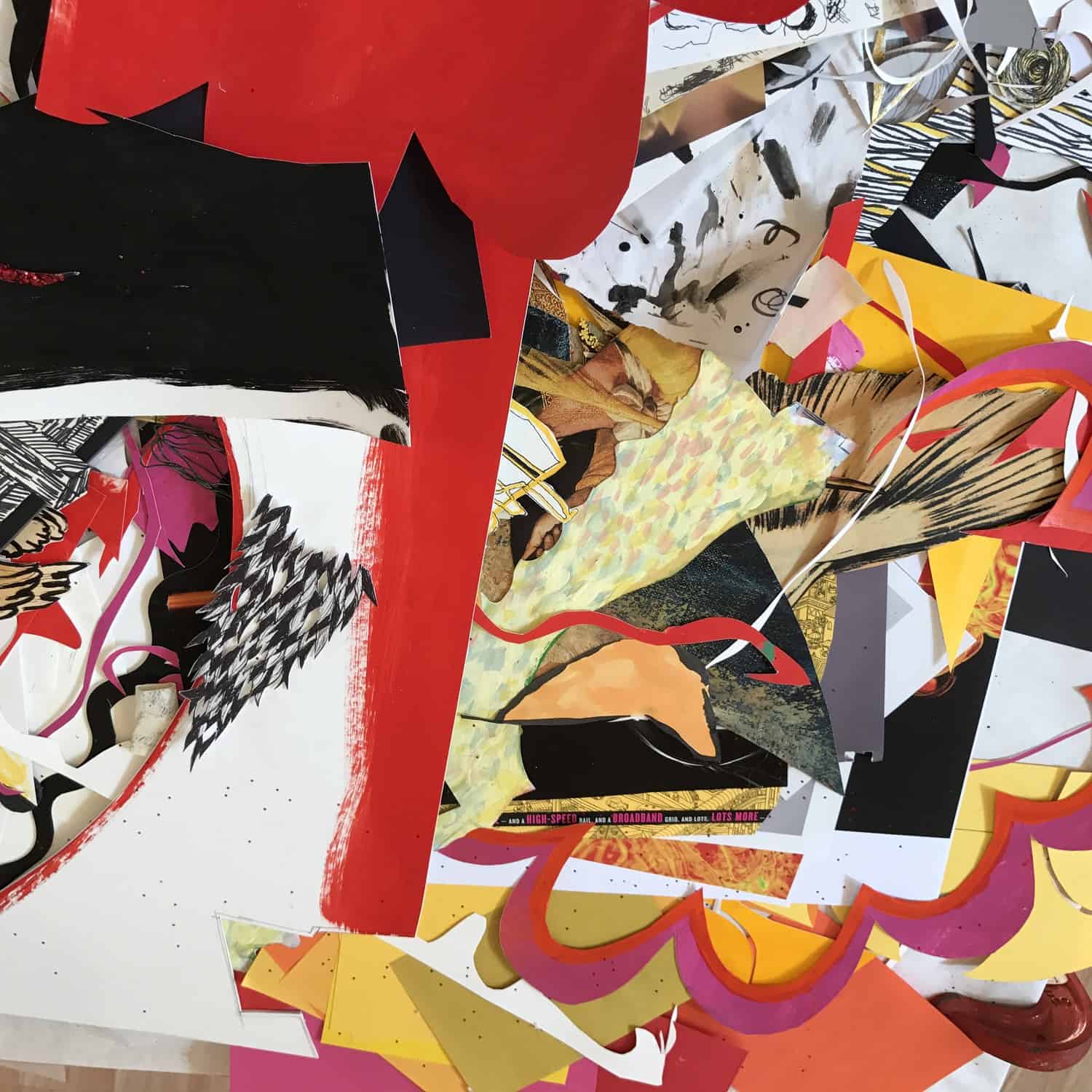
Thank you for including me in this article Ann. Such an honor. What an interesting and generous group of artists.
This article is so helpful, and timely. Terrific sure, so glad to connect with it. Thanks Ann